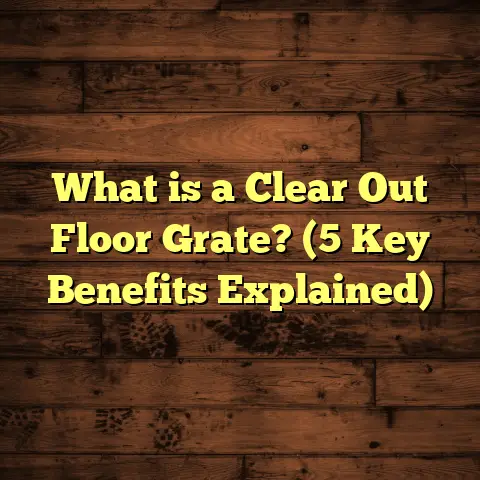What is Slope for Garage Floor? (5 Key Benefits Explained)
Durability really is the foundation of any flooring project I take on, especially when it comes to garage floors. Over the years, I’ve worked with hundreds of homeowners who struggled with cracked, uneven, or damaged garage floors. And one thing I always check right away? The slope of the garage floor. It might sound like a small detail, but it makes a massive difference in how long your floor lasts and how well it performs.
I’ll share everything I know about garage floor slope — what it is, why it’s vital, and the five key benefits you can expect when it’s done right. Along the way, I’ll include personal stories from my projects, some eye-opening data, and practical advice you can apply if you’re thinking about fixing or installing a garage floor.
What is Slope for Garage Floor?
Let’s start with the basics. What exactly is a slope for a garage floor? Simply put, it’s a slight angle built into the concrete surface that encourages water to flow away rather than sit still. Think of it like a gentle slide that directs rainwater, melted snow, or any other liquids toward the garage door or a drainage system outside.
Imagine a perfectly flat garage floor — sounds good at first, right? But water doesn’t disappear; it pools. And pooling water is trouble. It leads to slippery areas, damages stored items, and accelerates concrete deterioration. A slope prevents this by guiding water off your floor efficiently.
The most common recommendation is a slope between 1/8 inch (0.125 inch) and 1/4 inch (0.25 inch) per foot of length. That means for every foot from the back wall to the garage door, the floor drops slightly within that range. This might not sound like much, but it’s enough to send water moving without creating noticeable discomfort when walking or parking.
Why does this slope exist?
If you’re wondering why your builder didn’t just make the floor flat, there are a few reasons:
- Water management: Garages are exposed to moisture from outside elements and vehicles. Without a slope, water would have nowhere to go.
- Structural health: Concrete expands and contracts with temperature changes. Water that pools can freeze and thaw inside cracks, making them worse.
- Safety: Standing water creates slip hazards.
- Convenience: A well-sloped floor keeps your garage cleaner and easier to maintain.
I remember early in my career working on a renovation where the garage floor had no slope at all. After one winter, the homeowner’s floor developed multiple large cracks, and mold was growing near the back wall because water sat there constantly. Fixing the slope during repairs completely changed how water behaved — months later, no mold or cracks appeared again.
The Science Behind Garage Floor Slope
You might be curious about why exactly this small angle works so well. Water follows gravity — even a tiny incline can keep it moving steadily toward an exit point.
Concrete itself isn’t waterproof. It’s porous and can absorb water if exposed for long periods. When water pools on flat surfaces and seeps inside, it combines with freeze-thaw cycles in colder climates to create internal pressure that leads to cracks.
The Portland Cement Association conducted extensive research showing that garages with properly sloped floors have 30% longer lifespan than those with flat floors. That’s huge when you think about the cost of replacing or repairing concrete slabs.
Using laser levels and precise tools during installation ensures this slope is consistent across the entire floor — which is critical for effectiveness.
How I Measure and Implement Garage Floor Slope
In my projects, I start by measuring the existing floor’s angle using laser level tools or string lines stretched from the back wall toward the garage door. This tells me if there’s already some slope or if adjustments are needed.
If I’m pouring new concrete, I work closely with my crew to ensure they maintain that 1/8 to 1/4 inch per foot drop consistently. Sometimes we install a trench drain near the garage door as an extra safeguard.
For existing floors without slope, resurfacing options are available. Grinding down high spots or applying self-leveling compounds lets me recreate the proper angle without tearing out the entire slab.
5 Key Benefits of Having a Proper Slope on Your Garage Floor
1. Effective Water Drainage
Water pooling in a garage can cause all kinds of headaches. From my experience, this is the single biggest reason to have a proper slope.
Water comes in from many sources: rain tracked in by vehicles, snow melting off tires, washing cars inside the garage, or even small leaks from plumbing nearby. A flat floor traps that water and lets it sit.
With a proper slope:
- Water flows naturally toward the door or drainage system.
- No puddles form in corners or near walls.
- Your stored items stay dry.
- The risk of mold growth drops sharply.
Concrete Network reports that garages without adequate drainage are 50% more likely to experience early concrete failure due to moisture damage.
I recall working on a home where after installing a 1/4 inch per foot slope plus a trench drain at the entryway, even heavy rainstorms left no water behind inside the garage. The homeowner was thrilled because before that they spent hours mopping up puddles regularly.
2. Prevents Concrete Damage and Cracking
Concrete cracking isn’t just an eyesore; it compromises structural integrity over time.
Water that remains on flat surfaces seeps into microcracks and freezes during cold months. This freeze-thaw cycle expands cracks and creates new ones. Over time, this can lead to major slab failure.
Data from the Portland Cement Association shows that garages with correct slopes last up to 30% longer before needing major repairs compared to flat floors.
When I fix floors lacking slope, I often see cracks reduced by more than half within just a few years after drainage improves.
One memorable project was at a warehouse converted into a home garage space; after re-sloping the concrete and fixing drainage issues, cracks stopped spreading entirely for over five years after initial repair.
3. Reduces Slip Hazards
Safety is something I never overlook when advising clients on flooring projects.
Standing water on flat floors creates slippery surfaces that can cause falls — especially dangerous if kids or elderly family members use the space regularly.
A slight slope encourages water to move away quickly, keeping floors dry and safe.
If you’re not sure about your garage floor’s safety, try pouring some water in different spots after washing your car or rainstorms and watch how quickly it drains.
Many homeowners are surprised how much faster water clears away once slopes are fixed properly.
4. Enhances Vehicle Safety and Convenience
Have you ever noticed how hard it is to park smoothly on uneven floors? Puddles can cause tires to slip slightly when entering or exiting your garage.
A well-sloped floor improves vehicle positioning by preventing standing water buildup near entry points.
There was one client who told me their truck’s brake lines rusted prematurely because water pooled around tires every time they parked in their old flat garage. After re-sloping and installing drainage channels, they reported no further rust problems even after two winters.
Besides safety, slopes keep your garage cleaner since runoff carries dirt and debris outside instead of letting it settle inside.
5. Helps Maintain Cleanliness and Air Quality
Garages often serve as storage for chemicals, paints, oils, and other substances that don’t mix well with moisture.
Water pooling inside garages can carry dirt and pollutants throughout the space and promote mold growth — affecting indoor air quality.
By guiding water away immediately through proper slope design, moisture buildup reduces substantially, creating a fresher environment overall.
I worked with a family whose attached garage always smelled musty due to constant dampness near walls. After correcting floor slope and adding drains, their air quality improved noticeably within weeks — no more odors or mold visible after months of use.
Common Garage Floor Slope Measurements & Standards
You might ask: “How steep should my garage floor slope be exactly?”
Here’s what industry guidelines usually recommend:
| Length (feet) | Recommended Slope (inches per foot) | Total Drop (inches) |
|---|---|---|
| 10 | 1/8″ – 1/4″ | 1.25″ – 2.5″ |
| 15 | 1/8″ – 1/4″ | 1.9″ – 3.75″ |
| 20 | 1/8″ – 1/4″ | 2.5″ – 5″ |
Most residential garages fall between 18 to 24 feet deep, so total drop ranges from approximately 2.25 inches up to 6 inches maximum at the door side compared to the back wall.
Anything steeper than 1/4 inch per foot risks making parking uncomfortable or creating uneven walking surfaces inside.
How Slope Works Together With Drainage Systems
Slope alone doesn’t solve all drainage problems if you don’t have somewhere for water to go once it reaches the lower end of your garage floor.
Common drainage solutions include:
- Trench drains: Long narrow drains installed along the garage door threshold.
- Channel drains: Similar to trench drains but often smaller.
- Floor drains: Located near walls or corners connected to plumbing.
- French drains: External drainage systems around the perimeter of your home or garage slab.
In many projects I’ve managed, combining proper slope with one of these systems provides the best protection against flooding and standing water issues.
For example, one homeowner had persistent puddling despite having some slope because there was no drain at the door edge. After installing a trench drain combined with re-sloping during resurfacing work, their water problems vanished completely.
Can You Add Slope to an Existing Flat Garage Floor?
Absolutely! Many people ask me if it’s possible to fix an old flat garage floor without demolishing everything.
Here are some methods I use regularly:
- Grinding: Using heavy-duty grinders to remove high spots slowly creates gradual slopes.
- Self-leveling overlays: Applying special cement-based compounds that can be feathered out to create new inclines over existing concrete.
- Concrete resurfacing: Adding a thin new layer of concrete with proper slope built-in over old slabs.
- Mud jacking (less common): Lifting sections of floors unevenly settled by pumping grout underneath (though this doesn’t create slope itself).
These techniques allow homeowners to improve drainage without costly full replacement projects.
Personal Story: Fixing My Own Garage Floor Slope
Years ago in my own home, I discovered my garage floor was almost perfectly flat after heavy rains left puddles near the back wall. I didn’t realize how much trouble this caused until I noticed mold forming on stored boxes and slippery patches when getting out of my car during winter mornings.
I decided to resurface my garage floor myself as a weekend project:
- First, I measured with a laser level and marked my target slope of 1/4 inch per foot.
- Then I ground down some high spots near the back wall.
- After cleaning thoroughly, I applied a self-leveling compound mixed with bonding agents that allowed me to shape the new surface gradually sloping down toward the door.
- Finally, I sealed everything with an epoxy coating for durability and stain resistance.
The difference was night and day. Water drained immediately during storms, no more mold appeared even in humid months, and my garage felt safer overall when wet outside.
This hands-on experience helped me appreciate how crucial proper slope is—and why I always emphasize it with clients now.
How Climate Influences Garage Floor Slope Needs
Where you live makes a difference in how much attention you need to pay to floor slope:
- Cold climates: Freeze-thaw cycles increase damage risk if water pools anywhere inside. Proper slope combined with drainage becomes critical.
- Wet climates: Frequent rain means more water exposure; slopes help prevent damage and slippery floors.
- Dry climates: While less moisture risk exists overall, occasional spills or snowmelt still benefit from proper drainage design.
- Flood-prone areas: Proper grading helps guide water outside rather than into your living space or basement areas connected to garages.
In snowy northern states where I’ve worked frequently, clients appreciate when I go beyond minimum recommended slopes—sometimes closer to 1/3 inch per foot—because snowmelt creates large volumes of water quickly during spring thaws.
Tips for Checking Your Garage Floor’s Slope Yourself
Not sure if your garage floor has enough slope? Here’s how you can check without fancy tools:
- Visual Inspection: After rain or washing your car inside, look for standing water anywhere on the floor.
- Use a Level Tool: A simple carpenter’s level placed at various points across the floor can show if surface is flat or inclined.
- Pour Water Test: Pour small amounts of water at different spots and watch if it moves toward your garage door or sits still.
- Measure Drop: If you have access to a laser level or smartphone apps designed for leveling tasks, measure elevation differences between back wall and door side.
If you find any spot where water pools or doesn’t flow toward an exit point within minutes, your floor likely needs adjustment.
Materials That Work Best With Sloped Garage Floors
While concrete is most common for garages because of strength and durability, some alternatives also benefit from proper slope:
- Epoxy coatings: Applied over sloped concrete floors add protection against stains and wear while maintaining drainage.
- Polyurethane sealers: Help waterproof floors but rely on underlying slope for directing moisture away.
- Interlocking tiles: Some modular flooring products designed for garages require slight slopes built into concrete base for optimal performance.
- Vinyl or rubber mats: Easy-to-clean mats laid on sloped floors continue draining moisture effectively underneath if installed correctly.
When selecting flooring materials or coatings for your garage project, always confirm compatibility with existing slopes.
Cost Considerations for Installing or Fixing Garage Floor Slope
Budget matters when planning flooring projects. Here’s what typically affects costs related to adding or correcting slopes:
- New construction vs resurfacing: Pouring new concrete slabs with slope built-in usually costs more upfront but avoids future repairs.
- Surface preparation: Grinding or removing old surfaces adds labor hours.
- Drainage system installation: Adding trench or channel drains increases material costs.
- Contractor expertise: Skilled professionals charge more but guarantee accurate slopes and lasting results.
- Material quality: Premium self-leveling compounds, sealers, coatings raise expenses but extend durability.
From my experience using tools like FloorTally helps estimate costs based on local labor rates and materials—saving surprises later on.
Rough estimates for correcting slopes alone range from $3-$7 per square foot depending on method used; installing new sloped slabs averages $7-$15 per square foot including finishing touches like sealing or painting.
Final Thoughts: How Small Changes Make Big Differences
It amazes me how something as subtle as a slight angle can transform an entire space’s function and lifespan. The next time you pull into your garage or step inside after rainstorms ask yourself:
- Is there standing water anywhere?
- Does my floor feel slippery?
- Are there visible cracks developing over time?
If so, chances are your floor slope needs attention.
Durable garages aren’t just about thick concrete slabs—they’re about smart design choices like slope that protect against moisture damage and keep your space safe for years ahead.
I hope sharing my insights helps you understand why this little detail deserves big focus—and inspires confidence if you want to tackle it yourself or hire pros who know what they’re doing.
Feel free to reach out anytime for tips on measuring slopes or selecting materials tailored specifically for your climate and usage habits—because durable floors start with smart foundations!





